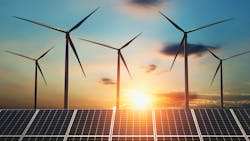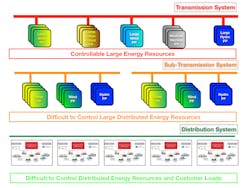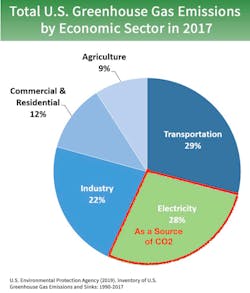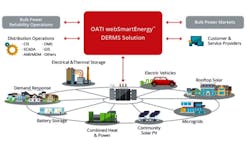A Practical Pathway for Our National Renewable Energy Future
Reducing carbon output from the American power grid is an essential goal, meriting urgent and committed attention. However, while accelerating the growth of low-carbon technology on the current U.S. grid for decarbonization is laudable (suggesting that all changes could be made within 10 years), it is currently impractical and enormously risky.
Grid At the Edge: How the Grid Works and Dealing with Risks
Reducing carbon output from the American power grid is an essential goal, meriting urgent and committed attention. However, while accelerating the growth of low-carbon technology on the current US Grid for decarbonization is laudable, it is currently impractical and enormously risky. Moreover, the consequences of proceeding at the speed some current proposals (suggesting that all changes could be made within ten years) would create unacceptable operational risks and add significant costs to the American power system.
The significance of these risks compels me to offer a practical perspective regarding the power-system aspect of a future based on renewable energy. I speak from 45+ years of global experience in power-related projects. Those projects include managing large generation facilities and developing computer systems supporting efficient, economical and reliable control of the electricity supply to numerous states in the US. Later developing large energy projects in the Middle East, Asia, Europe, and working for three major US energy producers and USAID in Afghanistan. Consequently, my thoughts about power systems and the power grid are based on extensive training and put forth with long experience in generation, power system engineering, computer systems and project management.
The New Grid
I call my concept the new grid, which encompasses generation (supply), transmission and distribution (T&D delivery), and end-use consumers including prosumers that also have supply via distributed energy resources (DERs) and other behind-the-meter supply. Successfully implementing this concept or something similar will undoubtedly be very costly. However, the large initial cost to implement a new grid will be an investment in our climate's long-term viability. These benefits to the climate will be achieved through significant decarbonization. At the same time, proper system design should lower grid operating and maintenance costs, and improve operational stability and security.
This article is a call to all stakeholders to transform energy production, transmission, and delivery systems to modernize the U.S. power grid and reduce carbon emissions. The ideas presented here intend to achieve a common sense version of the energy aspect of the Green New Deal (GND). The purpose of offering this perspective is to illustrate in broad-brush terms the technical complexity of the massive engineering efforts required to successfully shift from the current power grid system to a grid that can operate successfully using a complex mix of fuels. The article does not consider in detail the transportation, agricultural, industrial, and other sectors covered by the GND, each of which contributes to CO2 emissions and deserves comprehensive analysis.
The generation fuel sources will consist of reduced carbon fossil energy, nuclear resources, and widespread renewable energy (solar, hydrogen, wind, tidal, hydro, and so forth). Solar and wind are supported by battery (BESS), hydrogen, and other energy storage systems. The grid today is "just in time" with growing intermittent renewable energy.
"Energy storage capacity with estimated future needs at hundreds of gigawatts is needed to address growing penetrations of renewable energy in the United States moving the grid from 'just in time' to 'let's store some until needed'," said Michael Heyeck, founder, The Grid Group, LLC.
Recently, sizable generation requirements have been satisfied using large solar and wind generation installations. According to the U.S. Energy Information Administration (EIA), renewable energy is projected to be the fastest growing source of electric generation. However, the current grid has limitations to accelerated growth of zero-carbon technology. Grid decarbonization is commendable but it is impractical and enormously risky using the current grid design.
These fuel choices for the American power grid show that reducing carbon output is an accepted and important goal of the energy industry. These fuel choices mean that the American power grid designs are demonstrating that reducing the carbon output is a critical goal of the energy industry. According to the EIA, renewable energy will be the fastest growing source of generation. But many technical, political, and financial factors can impede the pace at which these changes occur. The views in my suggested new grid illustrate from a purely technical perspective how a successful carbon reduction program could be achieved.
Complete elimination of carbon from the power generation system, as proposed by some, is likely currently impractical. However, significantly reducing carbon from the power generation system is an achievable and vital objective deserving realistic and conscientious consideration. Successfully reducing carbon production depends upon the ability to deliver clean energy in a stable, secure, and resilient manner.
The 10-year timeline proposed by the GND is quite certainly too short to safely satisfy the requirements of a comprehensive carbon reduction plan. The unintended consequences of a hurried implementation to an inadequately designed power system transformation would be the creation of enormous risks for the American energy system, as listed in the risk highlights below.
Risk Highlights
By attempting to replace all fossil-fuel and nuclear energy with renewable energy in 10 years, the current proposal creates significant risks to the diverse and complicated American power grid. For example, the loss of large central power plants — which can quickly increase and decrease output to meet changing load requirements — jeopardizes the ability of grid dispatching authorities to control power flow and quality. Diminishing this ability can lead to the following:
- Poor control of voltage and frequency levels, and inability to control power factor. Each of these electrical qualities is essential to controlling and protecting the grid.
- Replacing the electric energy production of the reliable and controllable power plants with that generated from intermittently available renewable resources presents a risk. At the top of this list is a service that is known as operating reserves. “Penetration of intermittent resources like wind and solar will demand a level of operating reserves that are many times of the current level," said Nasser Jaleeli, CEO of priority-based Control Engineering.
- Decreasing the operating reserve, that is, the generating capacity available to the system operator within a short time to meet demand because of a significant loss of generation or other disruptions to the supply.
- Reducing the ability to manage system perturbations resulting in large area outages or cascading regional outages, or worse, the past major outages in the Midwest and the Northeast.
- The inability to reliably trade energy through system interconnections can result in regional outages because of loss of expected purchased power. In addition to creating outages, this lost ability to trade energy would have significant negative commercial impact on both productivity and reduced customer comfort.
Creating a generation system dominated by renewable energy requires significant modifications and additions to the current T&D systems. This new generation mix and new geographic redistribution require developing something like the new grid that I hypothesize in this article. The new grid also includes hydrogen and batteries as foundational energy storage and support systems.
An effective U.S. decarbonization plan will have a somewhat limited relative impact on the world (see Fig. 1). However, an effective U.S. decarbonization plan could serve as a global template and be a force-multiplier for global carbon reduction.
DER systems are decentralized, modular, and more flexible technologies that are located close to the load they serve, albeit having capacities of only 10 MW or less. These systems can comprise multiple generation and storage components. In this instance, they are referred to as hybrid power systems.
The transition to renewable DERs requires renewable distributed energy resource management systems (DERMS). Such new systems require redefining the interactions between energy generators and energy consumers. These interactions can also be viewed as virtual power plants (VPPs). The successful implementation of the cloud-based VPP concept requires enormous engineering effort. Overlaying the technical operation of these systems are the commercial platforms serving as the financial basis of the US$200 billion (2017) energy trading business.
America and the world need clean and resilient energy infrastructures that are suitable for the foreseeable future. Despite any arguments regarding reasons for climate change, no one should deny that reducing pollution from energy production based on combustion is a praiseworthy and vital goal. This goal will enhance health and prosperity, as well as climate restoration, all of which would be products of this visionary approach to renewable energy generation, transmission, and distribution.
In Fig. 1, the energy-related sector (in green) involves the generation, transmission, and distribution of electricity. According to the U.S. Environmental Protection Agency (EPA), CO2 comprises the majority of greenhouse gas emissions from this sector and electricity production generates the second largest share of greenhouse gas emissions. Fig. 2 shows that in 2017, approximately 62.9% of our electricity came from burning fossil fuels, mostly coal and natural gas. This article focuses on reducing CO2 from the energy sector.
Risk Mitigation
Managing these risks while reducing energy sector carbon emissions requires introducing new and innovative methods to produce and deliver energy. One solution involves developing a conceptually new delivery system (or the new grid) which augments or replaces the current grid, replacing the older smaller fossil generation and older nuclear plants with new low-carbon fossil plants, new small modular nuclear reactors, and large amounts of renewable DERs.
To increase the installed capacity of DERs from renewable energy sources, supporting regulations and financial incentives must encourage large solar and wind farms, as well as small customer-driven (residential) DERs. Reducing carbon emissions from transportation may require an added tax on gasoline. In a similar fashion, for ratepayers to enjoy the benefits of cleaner energy from solar, wind, and hydro-derived energy, they may need to pay a monthly environmental charge. It is likely, however, that reduced energy usage cost from renewable fuel-sourced energy (that is, free solar and free wind) will help offset this charge. Additionally, energy from residential, commercial, and industrial customers should also receive financial incentives to install hybrid power systems. One company supporting this concept is OATI.
Fig. 3 illustrates a system of aggregating energy from small- and medium-sized hybrid systems to become a significant source of clean energy for a power grid to capture and optimize. This solution is called a DERMS. By contributing large amounts of incrementally small, but cumulatively very large, amounts of energy, these hybrid systems could reduce grid demand and contribute significant metered energy to the grid.
The new grid connecting the new mix of energy resources must handle the primary task of stable grid power flow. This new complex arrangement requires significantly modifying or replacing many of the existing computer-based energy management and dispatching systems. These systems monitor, control, protect, and secure the grid. Moreover, the enterprise systems that manage commercial trading must be aligned with the new grid to function smoothly on a real-time basis.
In the remaining three parts of this series, the author will discuss how to achieve low-carbon renewable energy power system using the new grid, transitioning to DERs (old paradigm to new paradigm), and hydrogen fuel as a disruptor and power from hydrogen as a fuel.
Technical Acknowledgements
The author would like to thank the following colleagues for offering encouragement, comments, and review of this series. Their help was technical and editorial in nature and does not imply their endorsement of the concepts that the author describes. The views and opinions included within are those of the author and may not reflect those of the editors or any other person or entity that contributed to this article.
- John Gentile – Director of Cascadia Energy Technologies, LLC
- Daniel Udovic, PhD-EE, PE – CEO of Processor Innovations
- Dan Madden, PE – CEO of Eco Energy International
- Nasser Jaleeli, PhD-EE, PE – CEO of Priority-based Control Engineering
- Michael Heyeck, PE – Founder, The Grid Group, LLC
- Tim Lowe, PhD – VP of Eco Energy International
- Harry MacCormack, MFA – Board member of Ten Rivers Food Web
- Bernie Gagliano – Independent consultant and information architect
About the Author
Thomas A. McClimans
Thomas A. McClimans, P. E. is a director of Cascadia Energy Technology in Corvallis, Oregon. He has been enjoying a more than 45-year career in power generation (O&M), power plant construction, and computer control systems. Early in his career, McClimans implemented a groundbreaking direct digital control (DDC) system at an 800-MW coal-fired, super-critical generating unit at the Conesville Power Plant. He later became the youngest plant manager at Conesville, which was a 2000-MW generating station with over 600 employees and an annual budget in excess of US$150 million.
Since then, he has held senior level management and engineering positions in both domestic and international markets, working for such firms as American Electric Power (AEP), Black & Veatch International (BVI), NRG and TECO Power Services. Project responsibilities include EPC management, IT project management, O&M management, and generation portfolio management.
His assignments include some of the most challenging electric generating projects in the world. For example, as director of engineering computer applications for the AEP, he directed developing and implementing the computer control system for the AEP transmission grid and also implemented enterprise asset management systems for the AEP's fossil and nuclear generating plants.
Working as general manager for the BVI, he directed a generation optimization project for the 5000-MW Saudi Consolidated Electricity Co. in Jeddah, Saudi Arabia. Also working for the BVI, McClimans successfully directed redesigning and optimizing a waste-to-energy power plant in the United Kingdom and then managed several EPC projects in Thailand. Working as task manager for BVI-USAID, McClimans managed a project to help restore generation in Afghanistan. Working as general manager for NRG and TECO Power Services, he managed a multistate merchant power plant portfolio based on coal-fired boilers and gas-fired CCTs.
McClimans earned a BSc in electrical engineering from Ohio University. He is a registered professional engineer in Ohio and a life member of Institute of Electrical and Electronics Engineers (IEEE).



